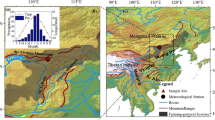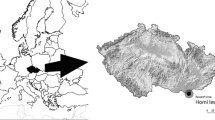Abstract
Daily stem radial growth of balsam fir [Abies balsamea (L.) Mill.] was studied between 1998 and 2001 using automated point dendrometers to investigate meteorological influence. By dividing the dendrometer day-night variation, the diurnal growth pattern was resolved into the three phases of (1) contraction, (2) expansion and (3) stem radius increment (SRI). The entire circadian cycle (4) defined by the three previous phases was considered as a fourth phase. The mean weather conditions of each phase were compared with the SRI using simple correlation and response function analysis. It was found that the weather conditions prevailing from 1600/1700 hours to 0800/0900 hours corresponding with the expansion-SRI phases had greater impact on SRI. Response function results confirmed most of the correlation analyses and explained up to 95% of the variance of the SRI series. Total rainfall in phases 2, 3 and 4 was correlated positively with SRI, and hence verifies the importance of daily water balance. The importance of water was also demonstrated by the negative effect of high vapour pressure deficit of phase 2, decreasing the possibility of cell radial expansion. The maximum temperature of phase 3 was the only temperature variable having a positive impact on SRI suggesting that night temperature was more important than day temperature in controlling radial growth. These results may influence the process of cell enlargement and reflect only the mechanical aspect of growth.







Similar content being viewed by others
References
Antonova GF, Stasova VV (1993) Effects of environmental factors on wood formation in Scots pine stems. Trees 7:214–219
Antonova GF, Cherkashin VP, Stasova VV, Varaksina TN (1995) Daily dynamics in xylem cell radial growth of Scots pine (Pinus sylvestris L.). Trees 10:24–30
Archambault S, Bergeron Y (1992) An 802-year tree-ring chronology from the Quebec boreal forest. Can J For Res 22:674–682
Blasing TJ, Solomon AM, Duvick DN (1984) Response function revised. Tree-ring Bull 44:1–15
Brooks JR, Flanagan LB, Ehleringer JR (1998) Responses of boreal conifers to climate fluctuations : indications from tree-ring widths and carbon isotope analyses. Can J For Res 28:524–533
Carrer M, Urbinati C (2001) Assessing climate-growth relationships: a comparative study between linear and non-linear methods. Dendrochronologia 19:57–65
Cheng C, Gordon IL (2000) The Richards function and quantitative analysis of germination and dormancy in meadowfoam (Limnanthes alba). Seed Sci Res 10:265–277
Dang QL, Lieffers VJ (1989) Climate and annual ring growth of black spruce in some Alberta peatlands. Can J Bot 67:1885–1889
D'Arrigo RD, Jacoby GC, Free RM (1992) Tree-ring width and maximum latewood density at the North American tree line: parameters of climatic change. Can J For Res 22:1290–1296
Denne MP (1971) Temperature and tracheid development in Pinus sylvestris seedlings. J Exp Bot 22:362–370
Deslauriers A, Morin H, Begin Y (2003) Cellular phenology of annual ring formation of Abies balsamea (L.) Mill. in the Québec boreal forest (Canada). Can J For Res 33:190–200
Downes G, Beadle C, Worledge D (1999) Daily stem growth patterns in irrigated Eucalyptus globulus and E. nitens in relation to climate. Trees 14:102–111
Dünisch O, Bauch J (1994) Influence of soil substrate and drought on wood formation of spruce [Picea abies (L.) Karst.] under controlled conditions. Holzforschung 48:447–457
Efron B (1979) Bootstrap methods: another look at the jacknife. Ann Stat 7:1–26
Fritts HC (1976) Tree rings and climate. Academic Press, New York
Guiot J (1993) The bootstrapped response function. Tree-ring Bull 51:39–41
Guiot J, Goeury C (1996) PPPBase, a software for statistical analysis of paleoecological and paleoclimatological data. Dendrochronologia 14:295–300
Hofgaard A, Tardif J, Bergeron Y (1999) Dendroclimatic response of Picea mariana and Pinus banksiana along a latitudinal gradient in the eastern Canadian boreal forest. Can J For Res 29:1333–1346
Irvine J, Grace J (1997) Continuous measurements of water tensions in the xylem of trees based on the elastic properties of wood. Planta 202:455–461
Jones HG (1983) Plants and microclimate :a quantitative approach to environmental plant physiology. Cambridge University Press, Cambridge
Keller T (1999) Variabilité climatique interannuelle quantifiée à partir de la densité et des isotopes stables de la cellulose du bois. Ph.D. dissertation, Université d'Aix-Marseille III, Marseille
Kozlowski TT, Winget CH (1964) Diurnal and seasonal variation in radii of tree stems. Ecology 45:149–155
Kozlowski TT, Kramer PJ, Pallardy SG (1991) The physiological ecology of woody plants. Academic Press, San Diego
Major JE, Johnsen KH (2001) Shoot water relations of mature black spruce families displaying a genotype × environment interaction in growth rate. III. Diurnal patterns as influenced by vapor pressure deficit and internal water status. Tree Physiol 21:579–587
Morin H (1994) Dynamics of balsam fir forest in relation to spruce budworm outbreaks in the Boreal Zone of Quebec. Can J For Res 24:730–741
Phipps RL (1982) Comments on interpretation of climatic information from tree rings, Eastern North America. Tree-ring Bull 42:11–22
Pietarinen I, Kanninen M, Hari M, Kellomaki S (1982) A simulation model for daily growth of shoots, needles, and stem diameter in Scots pine trees. For Sci 28:573–581
Ray PM (1987) Principle of plant cell expansion. In: Cosgrove DJ, Knievel DG (eds) Physiology if cell expansion during plant growth. The American Society of Plant Physiologists, Rockland, Md., pp 1–17
Richards FJ (1959) A flexible growth function for empirical use. J Exp Bot 10:290–300
Richardson SD, Dinwoodie JM (1960) Studies on the physiology of xylem development. I. The effects of night temperature on tracheid size and wood density in conifers. J Inst Wood Sci 6:3–13
Schweingruber FH (1996) Tree rings and environment dendroecology. Birmensdorf, Swiss Federal Institute for Forest, Snow and Landscape Research, Berne
Schweingruber FH, Briffa KR, Nogler P (1993) A tree-ring densitometric transect from Alaska to Labrador. Int J Biometeorol 37:151–169
Thibault M (1987) Les régions écologiques du Québec méridional. Deuxième approximation. Carte. Service de la recherche, ministère de l'Énergie et des Ressources du Québec, Québec
Worbes M (1999) Annual growth rings, rainfall-dependent growth and long-term patterns of tropical trees from the Caparo Forest Reserve in Venezuela. J Ecol 87:391–403
Zhang Q-B, Hebda RJ, Zhang Q-J, Alfaro RI (2000) Modeling tree-ring growth responses to climatic variables using artificial neural networks. For Sci 46:229–239
Zweifel R, Item H, Häsler R (2000) Stem radius changes and their relation to stored water in stems of young Norway spruce trees. Trees 15:50–57
Acknowledgements
This work was funded by the Consortium de recherche sur la forêt boréale commerciale, the Canada Foundation for Innovation, the Natural Sciences and Engineering Research Council of Canada and Le Fonds Québécois de la Recherche sur la Nature et les Technologies . The authors thank G. Dumont-Frenette for laboratory work, G. Dallaire, F. Gionest and G. Savard for field assistance.
Author information
Authors and Affiliations
Corresponding author
Rights and permissions
About this article
Cite this article
Deslauriers, A., Morin, H., Urbinati, C. et al. Daily weather response of balsam fir (Abies balsamea (L.) Mill.) stem radius increment from dendrometer analysis in the boreal forests of Québec (Canada). Trees 17, 477–484 (2003). https://doi.org/10.1007/s00468-003-0260-4
Received:
Accepted:
Published:
Issue Date:
DOI: https://doi.org/10.1007/s00468-003-0260-4




